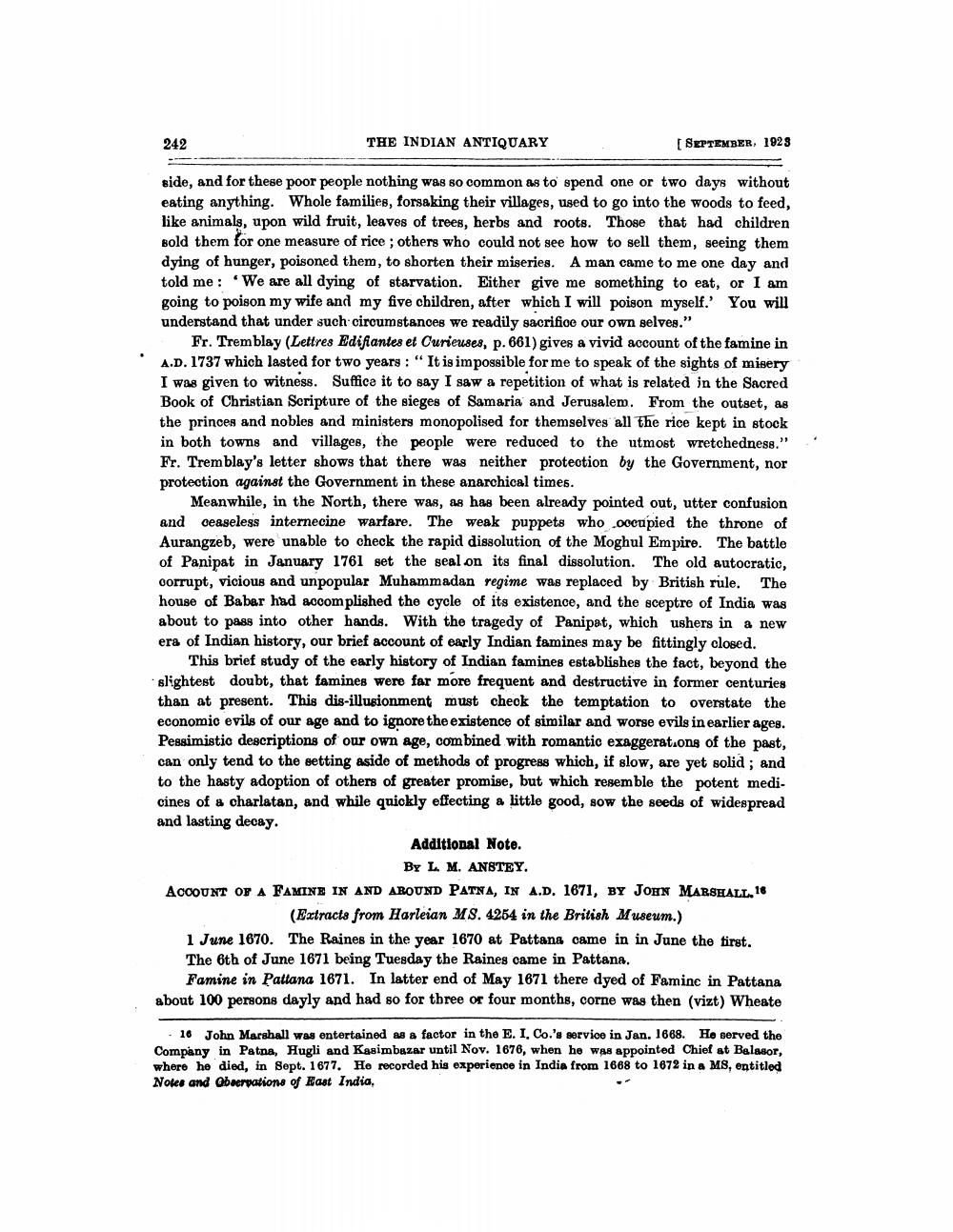________________
242
THE INDIAN ANTIQUARY
[ SEPTEMBER, 1928
side, and for these poor people nothing was so common as to spend one or two days without eating anything. Whole families, forsaking their villages, used to go into the woods to feed, like animals, upon wild fruit, leaves of trees, herbs and roots. Those that had children sold them for one measure of rice; others who could not see how to sell them, seeing them dying of hunger, poisoned them, to shorten their miseries. A man came to me one day and told me: We are all dying of starvation. Either give me something to eat, or I am going to poison my wife and my five children, after which I will poison myself.' You will understand that under such circumstances we readily sacrifice our own selves."
Fr. Tremblay (Lettres Edifiantes et Curieuses, p. 661) gives a vivid account of the famine in A.D. 1737 which lasted for two years : "It is impossible for me to speak of the sights of misery I was given to witness. Suffice it to say I saw a repetition of what is related in the Sacred Book of Christian Scripture of the sieges of Samaria and Jerusalem. From the outset, as the princes and nobles and ministers monopolised for themselves all the rice kept in stock in both towns and villages, the people were reduced to the utmost wretchedness." Fr. Tremblay's letter shows that there was neither protection by the Government, nor protection against the Government in these anarchical times.
Meanwhile, in the North, there was, as has been already pointed out, utter confusion and ceaseless internecine warfare. The weak puppets who .oocu pied the throne of Aurangzeb, were unable to check the rapid dissolution of the Moghul Empire. The battle of Panipat in January 1761 set the seal on its final dissolution. The old autocratic. oorrupt, vicious and unpopular Muhammadan regime was replaced by British rule. The house of Babar had accomplished the cycle of its existence, and the sceptre of India was about to pass into other hands. With the tragedy of Panipat, which ushers in a new era of Indian history, our brief account of early Indian famines may be fittingly closed.
This brief study of the early history of Indian famines establishes the fact, beyond the slightest doubt, that famines were far more frequent and destructive in former centuries than at present. This dis-illusionment must check the temptation to overstate the economic evils of our age and to ignore the existence of similar and worse evils in earlier ages. Pessimistic descriptions of our own age, combined with romantic exaggerations of the past, can only tend to the setting aside of methods of progress which, if slow, are yet solid; and to the hasty adoption of others of greater promise, but which resemble the potent medicines of a charlatan, and while quickly effecting a little good, sow the seeds of widespread and lasting decay.
Additional Note.
By L M ANSTEY. ACCOUNT OF A FAMINE IN AND AROUND PATNA, IN A.D. 1671, BY JOHN MARSHALL. 16
(Extracts from Harleian MS. 4254 in the British Museum.) 1 June 1670. The Raines in the year 1670 at Pattans came in in June the first. The 6th of June 1671 being Tuesday the Raines came in Pattana.
Famine in Pattana 1671. In latter end of May 1671 there dyed of Famine in Pattana about 100 persons dayly and had so for three or four months, corne was then (vizt) Wheate
- 16 John Marshall was entertained as a factor in the E. I. Co.'s service in Jan. 1668. He served the Company in Patna, Hugli and Kasimbazar until Nov. 1676, when he was appointed Chief at Balasor, where he died, in Sept. 1677. Ho recorded his experience in India from 1668 to 1672 in a MS, entitled Notes and Oberpations of East India.




